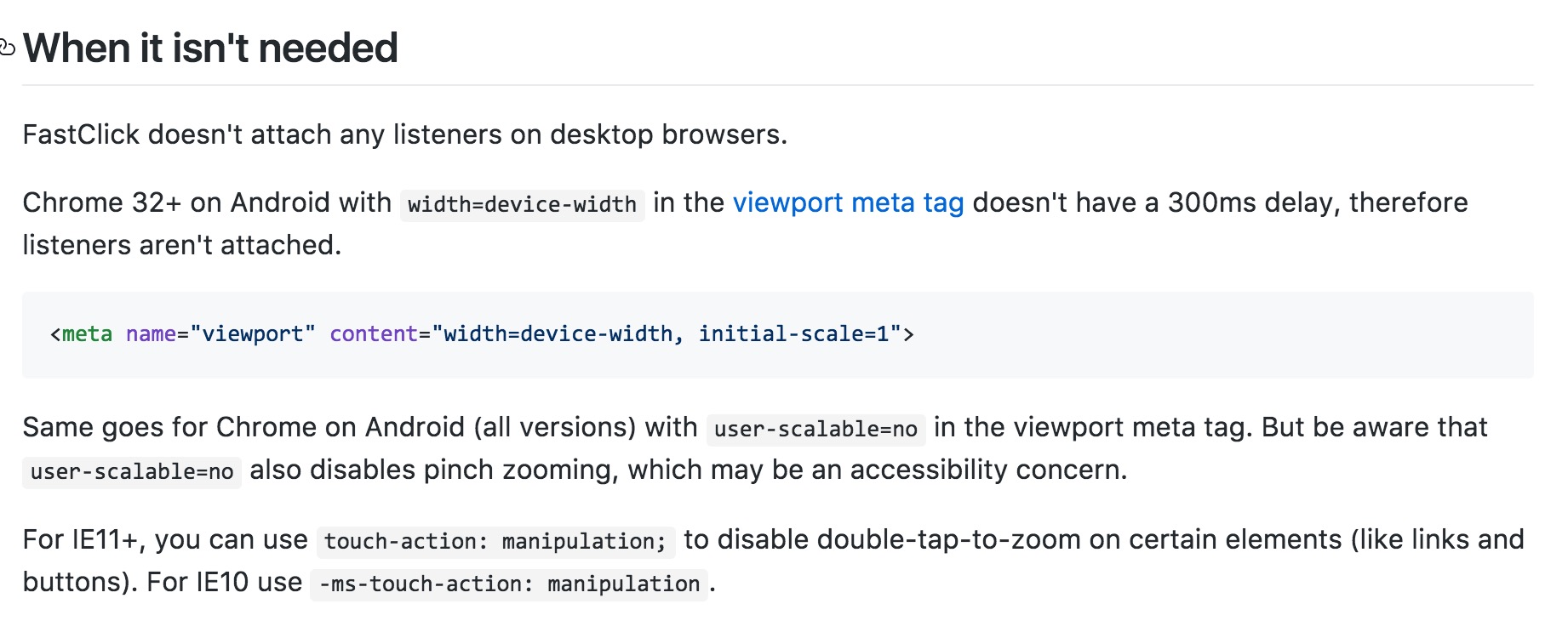faskclick
PC网页上的大部分操作都是用鼠标的,即响应的是鼠标事件,包括mousedown、mouseup、mousemove和click事件。一次点击行为,事件的触发过程为:mousedown -> mouseup -> click 三步。
手机上没有鼠标,所以就用触摸事件去实现类似的功能。touch事件包含touchstart、touchmove、touchend,注意手机上并没有tap事件。手指触发触摸事件的过程为:touchstart -> touchmove -> touchend。
当我们手触碰屏幕时,要过300ms左右才会触发mousedown事件,所以click事件在手机上看起来就像慢半拍一样。 为什么这么设计呢? 因为它想看看你是不是要进行双击(double tap)操作。用过Zepto或KISSY等移动端js库的人肯定对tap事件不陌生,我们做PC页面时绑定click,相应地手机页面就绑定tap。但原生的touch事件本身是没有tap的,js库里提供的tap事件都是模拟出来的。

不应用 FastClick 的场景,如果 viewport meta 标签 中设置了 width=device-width, Android 上的 Chrome 32+ 会禁用 300ms 延时;
<meta name="viewport" content="width=device-width, initial-scale=1">
viewport meta 标签如果设置了 user-scalable=no,Android 上的 Chrome(所有版本)都会禁用 300ms 延迟。
测试延迟情况
XX.ontouchstart = function(){ startTime =Date.now(); }; XX.ontouchend = function(){ pre.innerHTML += ('ontouchend : ' + (Date.now() - startTime) + '\n'); }; XX.onclick = function(){ pre.innerHTML += ('click : ' + (Date.now() - startTime)); }
if ('addEventListener' in document) { document.addEventListener('DOMContentLoaded', function() { FastClick.attach(document.body); }, false); } //优先兼容AMD方式 if (typeof define === 'function' && typeof define.amd === 'object' && define.amd) { define(function() { return FastClick; }); } else if (typeof module !== 'undefined' && module.exports) { //兼容commonJs风格 module.exports = FastClick.attach; module.exports.FastClick = FastClick; } else { //最后兼容原生Js window.FastClick = FastClick; }
核心方法
//391-450:onTouchStart FastClick.prototype.onTouchStart = function(event) { //tapDelay默认300毫秒,点击时间差小于300毫秒,则阻止事件再次触发,阻止短时间内双击的问题 if ((event.timeStamp - this.lastClickTime) < this.tapDelay) { event.preventDefault(); } } //521-610:onTouchEnd if (!this.needsClick(targetElement)) { // 如果这不是一个需要使用原生click的元素,则屏蔽原生事件,避免触发两次click event.preventDefault(); // 触发一次模拟的click this.sendClick(targetElement, event); } //294-309:sendClick(核心方法) //这个事件会在onTouchEnd中用到,经过一系列的判断,符合条件,调用这个模拟事件 FastClick.prototype.sendClick = function(targetElement, event) { var clickEvent, touch; //创建一个鼠标事件 clickEvent = document.createEvent('MouseEvents'); //初始化鼠标事件 clickEvent.initMouseEvent(this.determineEventType(targetElement), true, true, window, 1, touch.screenX, touch.screenY, touch.clientX, touch.clientY, false, false, false, false, 0, null); //触发这个事件 targetElement.dispatchEvent(clickEvent); };
用Zepto的插件touch.js中tap事件,来解决移动浏览器中300毫秒延迟的问题。但是出现了各种击穿现象
- 同页面tap点击弹出弹层,弹层中也有一个button,正好重叠的时候,会出现击穿
- tap事件点击,页面跳转,新页面中同位置也有一个按钮,会出现击穿
我们可以看下Zepto对 singleTap 事件的处理。见源码 136-143 行,可以看出在 touchend 响应 250ms 无操作后,则触发singleTap。
//trigger single tap after 250ms of inactivity else { touchTimeout = setTimeout(function(){ touchTimeout = null if (touch.el) touch.el.trigger('singleTap') touch = {} }, 250) }
- zepto中的 tap 通过兼听绑定在 document 上的 touch 事件来完成 tap 事件的模拟的,是通过事件冒泡实现的。在点击完成时(touchstart / touchend)的 tap 事件需要冒泡到 document 上才会触发。而在冒泡到 document 之前,手指接触和离开屏幕(touchstart / touchend)是会触发 click 事件的。
- 因为 click 事件有延迟(大概是300ms,为了实现safari的双击事件的设计),所以在执行完 tap 事件之后,弹出层立马就隐藏了,此时 click 事件还在延迟的 300ms 之中。当 300ms 到来的时候,click 到的其实是隐藏元素下方的元素。
- 如果正下方的元素有绑定 click 事件,此时便会触发,如果没有绑定 click 事件的话就当没发生。如果正下方的是 input 输入框(或是 select / radio / checkbox),点击默认 focus 而弹出输入键盘,也就出现了上面的“点透”现象。





